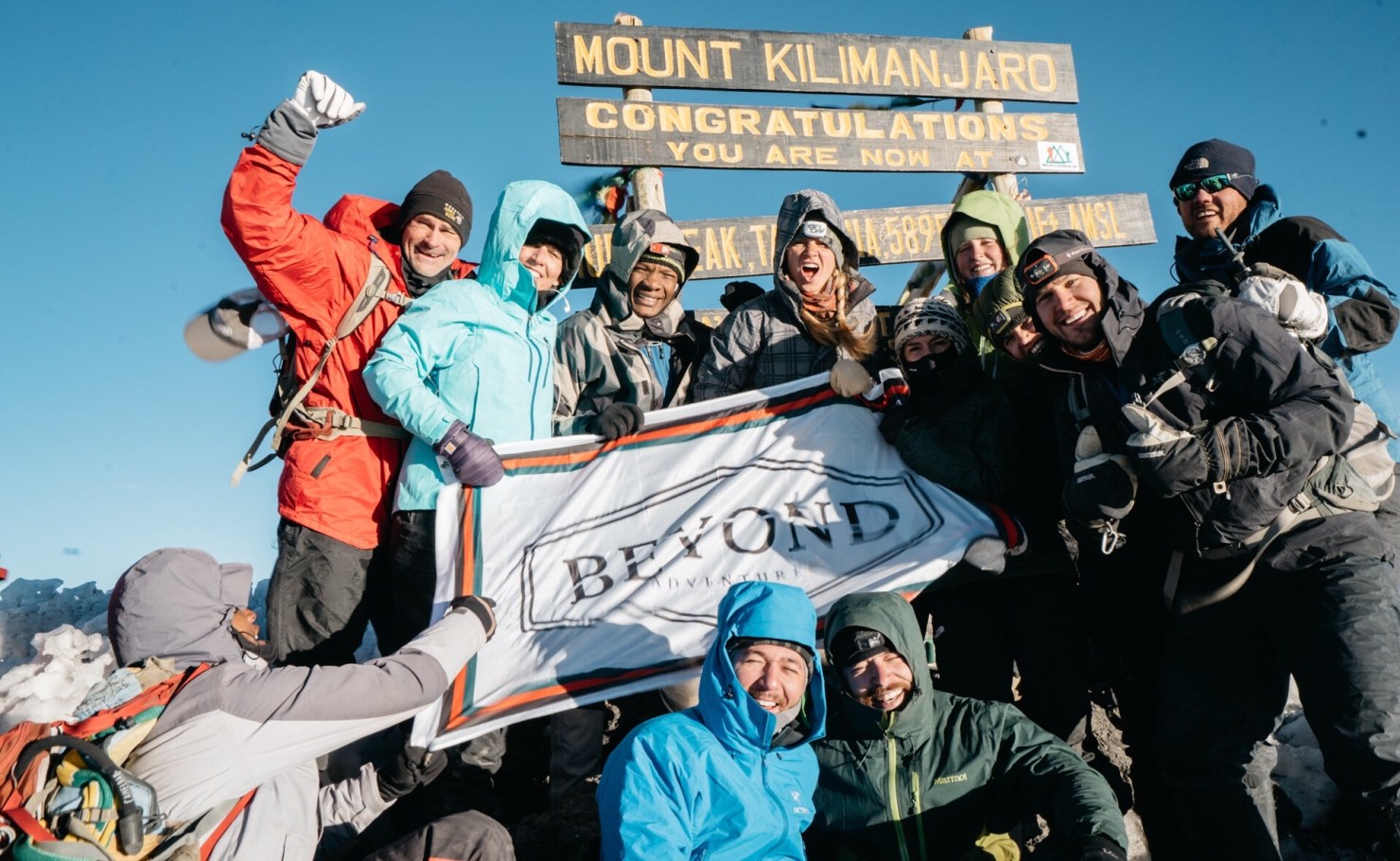Day 9: Climb to summit Uhuru Peak
MOUNTAIN ROUTE OVERVIEW
Summit night & day is tough as it ranges from an 11 to 16 hour day. Climbers go to sleep after an early dinner the night before and are awaken around midnight to prepare for the summit attempt. After a light snack, they will ascend in the darkness, cold and wind. Temperatures will usually range from -4° to 5° Fahrenheit. Altitude sickness is felt in various forms here on the mountain and climbers should be carrying as little as possible to help ease any symptoms.
They will make their way up a path that is flanked by The Ratzel and Rebman Glaciers, and climb for about six hours before reaching the edge of Kilimanjaro crater, between Stella and Hans Meyer points. Another hour of climbing will bring them to the summit!
Uhuru stands at 19,340 feet and is the highest point on the continent of Africa. The track around the edge of the crater is rocky and icy. Once they reach the summit, a short time is spent celebrating and taking photos, before returning to high camp, at Barafu. Here they will eat lunch and regain their strength, before continuing the descent to a much lower camp at Mweka.
The descent is no easier than the ascent. Climbers will be given the opportunity to rest and have some refreshments before continuing on to Mweka Camp for the night. Arriving into camp this evening, you will have trekked a total of around thirteen hours today.
ASCENT CLIMB DATA
Begin ~ 15,400 Feet / 4,660 Meters
End ~ 19,344 Feet / 5,896 Meters
Elevation Gain 3,944 Feet
Time Average 8-10 Hours
Distance Hiked 4 Miles / 7 Km
DESCENT CLIMB DATA
Begin ~ 19,344 Feet / 5,896 Meters
End ~ 10,200 Feet / 3,100 Meters
Elevation Loss 9,144 Feet
Time Average 7-9 Hours
Distance Hiked 8 Miles / 13 Km
CLIMBER BLOG ENTRY
The last full day before summiting began at the Karanga Camp, at about 12,500 feet. Our group broke camp about 8:30 and began a 5 hour hike on a gradual uphill course that took us around to the eastern face of the mountain where our path up that evening was finally visible. A narrow stretch of rock and gravel in between two long fingers of ice and fresh snow would become our journey’s final leg.
We stopped at Shira Camp at 1:30 and had lunch. The Camp was already bustling with multiple groups of other climbers and guides, busily getting ready for the final ascent that evening. Our guides, however, wisely suggested we advance up a difficult rock faced slope to Kosovo Camp at 16,000 feet so we would not be beginning the final midnight assault climbing that same daunting escarpment first.
After a 6:30 pm dinner of hot soup, and more starches than most of us had eaten in months, our group of 23 retired to bed. A strong east wind began to blow 25 – 30 MPH, and everyone snuck into their tents as the wind increased in its intensity through the early evening, praying that the wind would die down before midnight.
Our guides had broken the group into the “fast” group, and a slower group, as their goal was to have all of us reach the Summit at the same time. You can guess what group I was in…… At half past midnight, the first group left Kosovo, for the long 3500 ascent up the final leg of the Macheme Route. It would take 5+ hours.
The east wind became a constant howl, increasing in intensity as the night dragged on, hitting us from the right and often knocking many of us off balance as we attempted to use our hiking poles for stability. The trail terrain alternated between rock steps and a fine gravel which made climbing extremely difficult in the wind. About 17,500 feet we began to see ice on either side of the trail lit up in our trail lamps. When one paused to look up or down the hill, a series of white a red lights snaked and undulated their way upward on the mountain.
About 4:30 AM our two groups connected on the steep for the final assault on the crater rim, known as “Stella Point”, and at 5:30 the eastern sky finally began to lighten, first in a slight red glow, and then a band of red, yellow and white light. Above the cloud line, seeing the curvature of the earth, this view was the same astronauts see from their orbiting space craft as the sun moves up from below the horizon. It was mesmerizing, even in the intense cold and wind.
At between 5:45 and 6 AM, our group – all 23 of us – reached Stella Point. In front of us was Kilimanjaro’s massive volcanic crater, blanketed in snow and ice, reflecting the reds and yellows of the morning sunrise. Below us, a solid sheet of cloud cover, and the last third of the three volcanic peaks, Mwenzi, poked its jagged edge up through the white clouds, which along with Shira, make up the Kilimanjaro mountain ridge line. It was simply breath-taking. And hard for many of us to truly experience, as the wind continued its fierce attack, with gusts now exceeding 50 MPH, with the outside air temperature well below freezing, made wind chills below zero degrees fahrenheit.
There were many stories of courage by all our group, some hampered by bad knees, physical exhaustion, and all of us disoriented by the wind, altitude, and temperatures. Donning cramp- one for the 4’ plus deep ice along the trail, of our group continued around the rim to the west the next 1/2 mile and additional 450 feet to reach Uhuru, the highest part of the crater’s edge.
Pictures were taken, people hugged each other, flags and hats were produced to celebrate this group or that. And family pictures were taken, all in this very inhospitable environment. Then each of our climbers began the long descent back down to Kosovo, “skiing”down the 45 degree slope through loose rock, arriving in Camp about 9:30 to 10 AM, exhausted.
As our different groups arrived back in Camp over 2 hours, stories of individual hardship and accomplishment were shared, but in the end, were all exhilarated by the fact the entire team made it! After a quick lunch at 12:30 pm, our team broke Camp and moved down to Millennium Camp at 12,500, for our last night on the mountain. A 3 hour hike dropping 4,000 feet. Tired, exhausted, but grateful for accomplishing this journey as a group and individually, our team slept well in our now well worn, and dust filled tent homes of the last 6 days.
Tomorrow could come soon enough, as people dreamed of warm showers, a good nights’ sleep in a real bed, and regular food once again.
Bob (“Babu”)














